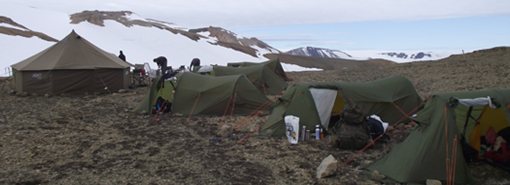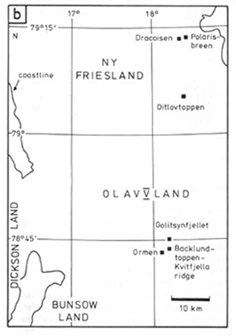 Initial fieldwork was carried out during the summer of 2010 with a party of 6 geologists from University of Birmingham, University of Wales Aberystwyth, New Mexico Highlands University and the University Centre in Svalbard.
Initial fieldwork was carried out during the summer of 2010 with a party of 6 geologists from University of Birmingham, University of Wales Aberystwyth, New Mexico Highlands University and the University Centre in Svalbard.
The field area is located in North East Spitsbergen, the main island in the Svalbard Archipelago. The aim of the fieldwork was to provide field observations and to permit the collection of sample suites for analyses in the UK and at international collaborating institutions. The localities studied during the 2010 field season provided excellent outcrop of Neoproterozoic glacial deposits. Relatively steep dips and repetition of strata through faulting allowed older and younger stratigraphic units to be sampled from a given campsite.
 The project will involve two major field seasons in 2010 and 2011. The 2010 work focused on nunataks in Olav V Land and Ny Friesland, supported by helicopter. The priorities in 2010 were to visit successively: a) the Dracoisen area, adjacent to Polarisbreen, Ny Friesland; b) Ditlovotoppen, southern Ny Friesland; c) nunataks in the Wilsonbreen area of Olav V land. Self-contained field camps will be set up on nunataks or the adjacent glaciers.
The project will involve two major field seasons in 2010 and 2011. The 2010 work focused on nunataks in Olav V Land and Ny Friesland, supported by helicopter. The priorities in 2010 were to visit successively: a) the Dracoisen area, adjacent to Polarisbreen, Ny Friesland; b) Ditlovotoppen, southern Ny Friesland; c) nunataks in the Wilsonbreen area of Olav V land. Self-contained field camps will be set up on nunataks or the adjacent glaciers.
The work will involve the documentation of geological relationships by photography and video sequences and the collection of geological samples. Given the remoteness and protected nature of the area, the thorough documentation of the relationships through images will make the key observations available to the international community with a minimum of disturbance by visits. However samples will be collected in order to make precise physical and chemical measurements of the rock properties to deduce their origin. The samples will be archived and available to the international community at the end of the project.
Fieldwork in 2011 will comprise a two week trip by skidoo by between 4-6 members of the research team to carry out reconnaissance over a number of nunataks. It is also proposed to have a 10-day field visit to the west coastal region of Nordaustlandet for a larger group of 10-15 persons, including representatives of the international community working on the Cryogenian. Such a visit is likely to be vital in addition to posting of images of the rock successions to convince the international community of the quality of the rock succession. The Nordaustlandet work would be on-land and of the same type as in 2010, but based from a boat for overnight accommodation.